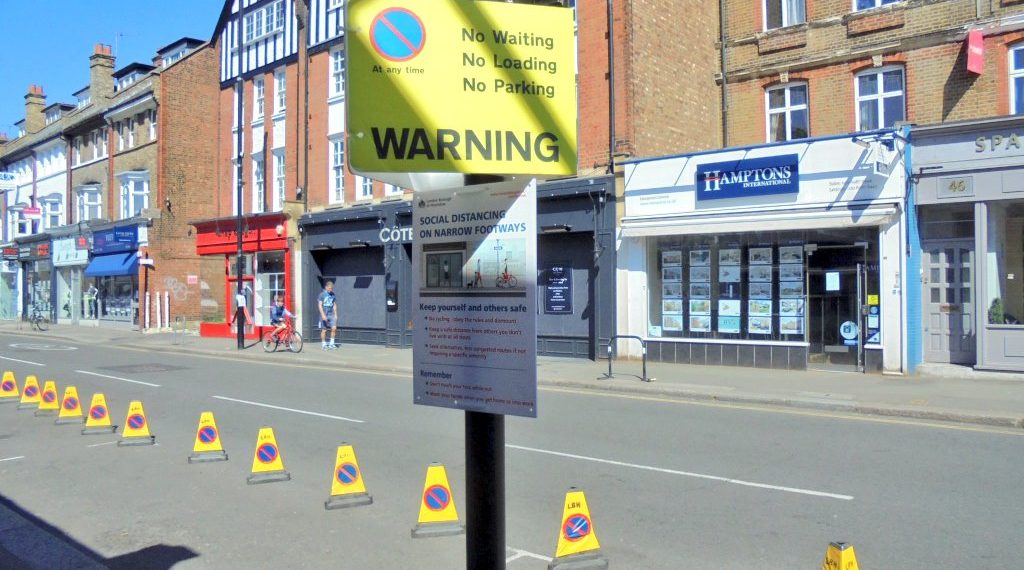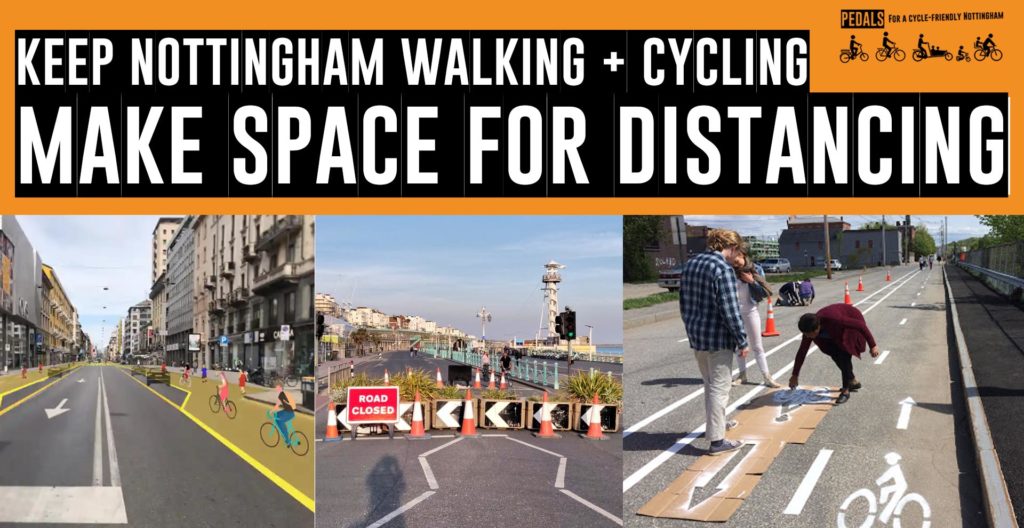
Take action NOW! We need you to contact your local councillors and ask them to –
- Make more space for people cycling and walking to keep people safe and avoid future transport chaos.
- Write a message in your own words.
- Talk about your own experiences of cycling and walking in Nottingham during Covid-19.
- Think about your friends and family members who may have cycled for the first time recently. What would help them keep cycling when restrictions are eased?
- Link to this blog post for ideas about what they can do and for more information.
Thank you!
Everything you need to know
Yesterday, the Government told transport authorities “to reallocate road space for significantly-increased numbers of cyclists and pedestrians.” We agree and think this is necessary so that people can travel around the city safely during Covid-19 and beyond.

This is especially crucial in Nottingham, a city which currently has relatively low car ownership (44% of households don’t have access to a car), high levels of public transport use, and ambitious Carbon Neutral plans.
Social distancing measures mean that public transport capacity is going to be significantly reduced for a long time. We’re going to have to change the way we move around, but this is a crisis which cannot be solved by simply adding more cars to our roads.
We’re seeing cities across the country and around the world make radical changes to their streets – we want Nottingham to do the same.
We’re asking Nottingham City Council and Nottinghamshire County Council to take the following actions.
Changes which can be made right away
Make all bus lanes 24 hour so that people can cycle in them and prevent parking
- While bus demand is lower and bus frequencies are reduced, bus lanes have become good cycling infrastructure.
- We’re asking for all bus lanes to become 24-hour to prevent parking in them so that people cycling can use them at all times.
- It would allow safer access to the city’s hospitals by providing safer cycling conditions on Hucknall Road and Derby Road, both very hostile places to cycle due to speed and volume of traffic.
Make advisory cycle lanes mandatory and prohibit parking in them
- All advisory cycle lanes should be converted into mandatory cycle lanes in order to keep them free of parked vehicles. [Difference explained here]
- These cycle lanes should be further protected by installing protection such as wands to keep motor traffic out.
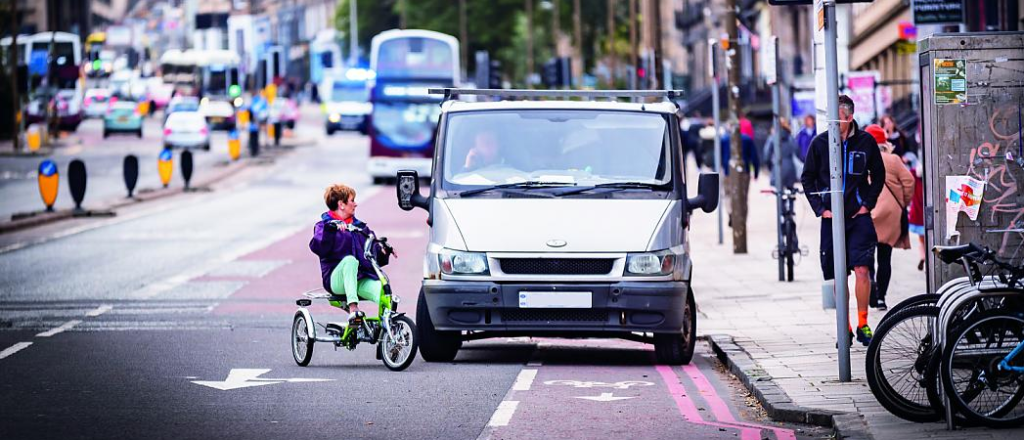
Photo by Cycling UK
Give priority at pedestrian and cycle crossings
- Timings should be adjusted on busy crossings so big groups of people don’t form waiting for a green light to cross.
- Manchester have announced that “timings have been reduced at around 1,000 signalised crossings“
- Crossings should automatically turn green for people waiting by using detectors and timings. This would eliminate the need to touch surfaces by pressing a button in order to cross.
- Bradford have modified their pedestrian crossings “to automatically provide a ‘green man’ crossing signal”
- When at rest, crossings should default to green for walking and cycling, rather than green for the traffic lanes.
Stop people parking cars on pavements
- Enable people to keep a safe distance from each other when walking by cracking down on pavement parking.
“Hyson Green could do with some help. If the paved area outside the post office and pharmacy on Gregory Boulevard could have no cars parked on it then there’d be much more room for those queuing for the post office and pharmacy to stand without blocking those needing to pass.” [Link]
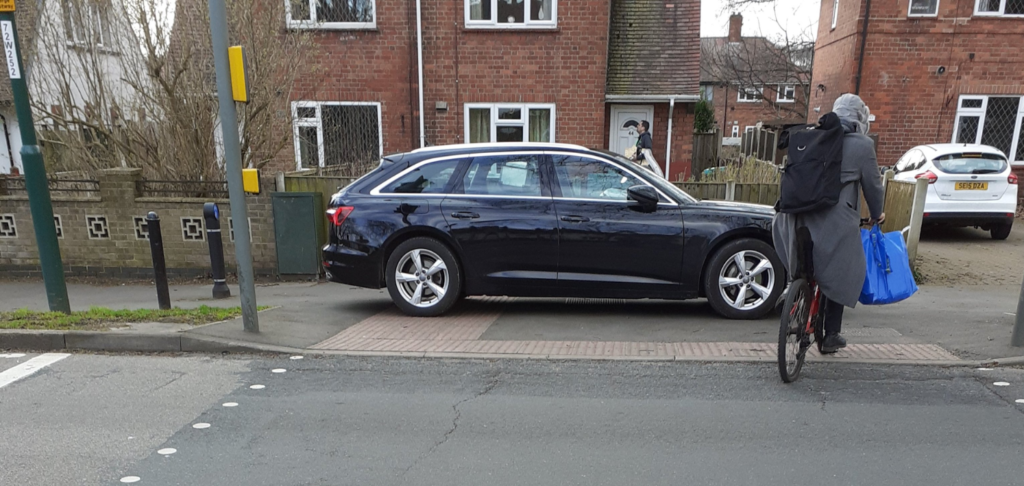
Get trial infrastructure in quickly and refine it in the longer term
The things we’re suggesting in this section are more substantial, and will have a bigger positive impact than the changes above. They may take a bit longer to implement, so we need to start working on them right away.
“Measures should be taken as swiftly as possible, and in any event within weeks, given the urgent need to change travel habits before the restart takes full effect.”
DfT – Traffic Management Act 2004: network management in response to COVID-19
Low traffic neighbourhoods
- People are now spending more time than usual in their local neighbourhoods. It is important that we make these attractive places to be in and move around.
- We should create neighbourhoods that are low traffic or traffic free, providing a more pleasant environment that encourages people to walk and cycle, and improving safety.
- This can be done by using modal filters (also known as filtered permeability) to prevent rat-running, for example by using planters or large barriers.
- An example we like from Hackney.
Reallocate road space on big roads
There are many roads across the city with multiple lanes and either no space for cycling or space which is shared between cycling and walking. Many of the pavements are too narrow to stay a safe distance from other people. Space on these roads should be allocated to cycling, allowing people to cycle at a safe distance from pedestrians and without any fear of cars.
- Leicester have created a “Key Worker Corridor” leading to a local hospital by recallocating a general traffic lane to cycling by marking it out with traffic cones.
- The City of York have transformed a narrow traffic lane on their inner ring road into a bike lane using cones.
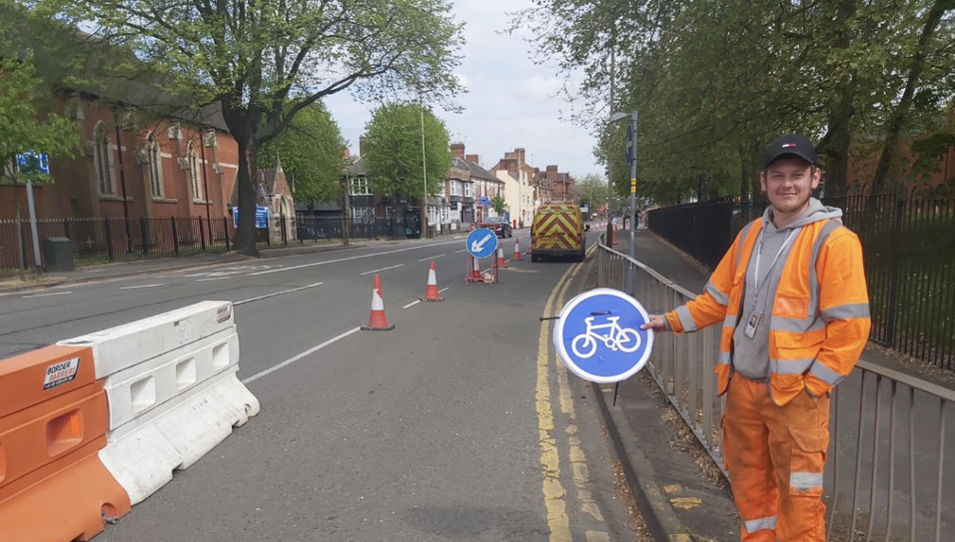
Leicester City Council’s Pop-Up Cycleway
High Streets on main roads
- Many of our high streets have narrow pavements which aren’t wide enough to give people the space needed to safely walk past each other.
- Most of these areas have on-road parking which could easily be suspended, coned off and given over to pedestrians.There are numerous local examples in Nottingham, including Sherwood, Hyson Green and Alfreton Road.
- Richmond and Croydon have recently done this.
Trent Bridge bottleneck
- The pavements on Trent Bridge are narrow and people walking are trapped in by scaffolding and barriers. The road is especially hazardous for people who cycle.
- This has been raised time and again as a key location where social distancing is not possible.
“I always feel vulnerable when I cycle over Trent bridge since the pedestrian protection barriers where put into place ….if a car swiped you with a close pass you would have nowhere to go” [Link]
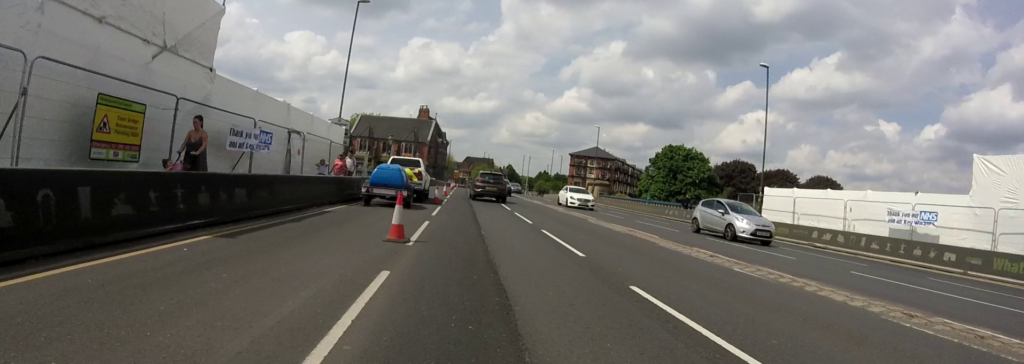
- Going forwards, Trent Bridge will be a key reason that people will be unable to cycle to and from the city from West Bridgford.
- We suggest that the space which is currently coned off for gas works is retained and used for cycling.
Why is this so important?
- Public transport capacity is down by 90% due to social distancing restrictions [link] and people may be hesitant to use public transport when restrictions are lifted [link]
- To prevent a dramatic increase in car use and increased desire to buy a private car as seen in Wuhan, China (and widely predicted elsewhere) [link]
- Enable people who have started cycling during Covid-19 to keep cycling in the future.
- More people using traffic free routes such as canal paths mean they are too busy for cycle journeys [link]
- Current facilities will not be able to cope with an increase in cycle journeys.
Recovery
“Authorities should monitor and evaluate any temporary measures they install, with a view to making them permanent, and embedding a long-term shift to active travel as we move from restart to recovery.”
Department for Transport, 9th May 2020
As we come out of this situation, we should convert temporary measures into permanent ones, to help keep the number of people walking and cycling at a high level.
Take action NOW! We need you to contact your local councillors and ask them to –
- Make more space for people cycling and walking to keep people safe and avoid transport chaos.
- Write a message in your own words.
- Talk about your own experiences of cycling and walking in Nottingham during Covid-19.
- Think about your friends and family members who may have cycled for the first time recently. What would help them keep cycling when restrictions are eased?
- Link to this blog post for ideas about what they can do and for more information.
Thank you!
